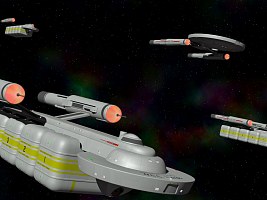Indus Class
Although interstellar hydrogen may be collected with the Bussard ramscoops of a starship, this provides only an emergency supply. In normal starship operation the deuterium tanks are refilled at latest once the fuel level has dropped to 20%. By 2280, Starfleet had established a dense network of refineries and of space stations with large supplies of deuterium and other consumable supplies. It was not necessary any longer to permanently assign tankers to certain fleet units and regions of space. Especially many older and smaller tankers became dispensable. On the other hand, delivering fuel to stations without their own deuterium collectors and refining facilities as well as emergency and combat supply still had to be provided by tankers. The Indus class was built particularly for the latter purpose, and with their top sustainable speed of Warp 5.0 the vessels were able to follow fleet movements, other than the already existing tankers such as the Hakudo Maru class. The project began in 2280, the prototype was launched in 2289.
Starfleet did not want to become the design of their support ships too expensive, so it was one requirement to employ the same warp nacelles that had been developed for the Asia refit, and to create largely the same warp field geometry. This design objective limited the size and shape of the fuel containers to a certain window inside the warp bubble, but it was actually a benefit, since it allowed a both fast and cost-efficient ship. On the other hand, the warp core had to be redesigned to a horizontal orientation, to fit into the shallow spine on top of the fuel tanks. There are five tanks altogether. Each of them has two main compartments (port and starboard) and twelve sub-compartments which are physically separated and operated independently during the transport. The distributed temperature, pressure and leakage control facilitates the overall handling of the large amount of fuel, and it provides comfortable redundancy. In case of a failure, it is possible to vent each sup-compartment separately without impairing the other compartments. Each tank has an outer hull of duranium with structural enforcements, SIF and shielding, a first insulation layer, a compartment hull made of stainless steel, a second insulation layer, and a sub-compartment hull made of cortanium-coated steel. The total internal volume of one tank amounts to 28,619 cubic meters, the normal storage temperature is 17.7K. With five tanks, the Indus-class carries enough fuel for complete refills of ten cruiser-type starships of the late 23rd century (or, as a modern-time equivalent, for two Galaxy-class ships). Aside from the large deuterium tanks, the Indus is capable of carrying antimatter pods in a special section behind the main deflector. It was the original idea to make each pod separately ejectable, but safety and efficiency considerations led to the solution to jettison the entire section in case of a pending containment failure in one of the pods.
The Indus class has a bow shuttlebay with a standard complement of two shuttlecraft and eight work bees. Safety regulations require the tanker and the ship to be refilled to stay at least one kilometer apart. This is why the initial idea of deploying a fully automated manipulator arm to the refill port was dropped. Instead of this, work bees (usually remote-controlled) are used to tow a conventional hose. This rather old-fashioned procedure takes considerably longer than a fully automated refueling. On the other hand, modern starships with subspace driver coils need to be refilled at most once a year. Automated refilling has eventually been introduced as late as in the 2360s. Although the Indus class is 90 years old by now and not likely to be refitted with new tanks and automated fuel ports, the ships (which had become indispensable in the Dominion War) are expected to stay in service for another ten years.
As it was with previous tanker types too, the Indus class has no shipboard weapons. Tankers are always an easy target for threat forces, as a single shot penetrating the shields may blow up a fuel compartment, which inevitably destroys the whole ship. In order to lower the risk, tankers are always escorted by a cruiser-type starship. In tanker convoys, Starfleet usually assigns one escort ship to each tanker, as opposed to normal cargo convoys where there is mostly only one escort per five cargo ships.
Gallery
Datasheet
| Class specifications Ship type: Deuterium tanker Length: 236m Width: 81m Height: 53m Crew complement: 19 Max. speed: Warp 5.0 First commissioned in 2289 |
Commissioned ships USS Indus NCC-4025 USS ParanŠ NCC-4115 USS Mekong NCC-4116 USS Rhein NCC-4117 USS Thames NCC-4118 USS Elbe NCC-4119 USS Irtysch NCC-4120 USS Kura NCC-4355 USS Mackenzie NCC-4356 USS Ganges NCC-4357 USS Rio de la Plata NCC-4358 USS Daugava NCC-4359 USS Limpopo NCC-4360 USS Murray NCC-4361 USS Fleuve St. Laurent NCC-4362 USS Potomac NCC-4363 USS Huang Ho NCC-4364 USS Niger NCC-4365 USS Oranje NCC-4366 USS Arno NCC-4367 USS Douro NCC-4368 USS Krishna NCC-4369 USS BŁyŁk Menderes NCC-4370 USS Severn NCC-5084 USS Roanoke NCC-5085 USS Shannon NCC-5086 USS Guadalquivir NCC-5087 USS Loire NCC-5088 USS Strymon NCC-5089 USS Jordan NCC-5090 USS Onega NCC-5091 USS Brahmaputra NCC-5092 USS Tigris NCC-5093 USS Amudarja NCC-5094 USS Lena NCC-5095 USS Ob NCC-5096 |
Credits
Thanks to Lennier and Tadeo D'Oria for their 3D models.







 Detailed three views
Detailed three views











